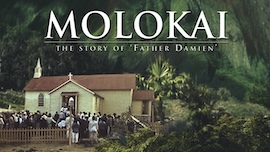Damien Chose Living Death with Hawaiians Cast Out for Leprosy
WAILING ROSE FROM THE SHIP Kilauea as fifty lepers, forever separated from their families, were transported to the isolated peninsula of Molokai. Though the Hawaiian archipelago was blessed in many ways, leprosy cursed its inhabitants. By 1873, of its forty thousand islanders, two thousand suffered from the disease. Those aboard the ship would join the ranks of the infected, resigned to exile on Molokai’s lonely peninsula. Aboard this same ship, however, was thirty-three-year-old Catholic priest and missionary Father Damien. Insisting, “I am ready to be buried alive with those poor wretches,” he had volunteered to immure himself in Hawaii’s leper colony for the remainder of his life.
On this day 4 May 1873, the bishop, Monseigneur Maigret, accompanied Damien onto the beach. Damien had never seen individuals in the late stages of the disease and turned white at the sight of swollen and rotted features. Bishop Maigret offered him a final chance to back out, but Damien shook it off. He would stick to his word.
Conditions were deplorable. Old residents said, “In this place there is no law.” Damien set out to change that. As he later described it,
Under the primitive roofs were living pell-mell, without distinction of age or sex, old or new cases, all more or less strangers one to another, those unfortunate outcasts of society. They passed their time with playing cards, hula (native dances), drinking fermented ki-root beer, home-made alcohol, and with the sequels of all this. Their clothes were far from being clean and decent, on account of the scarcity of water, which had to be brought at that time from a great distance. Many a time in fulfilling my priestly duty at their domiciles I have been compelled to run outside to breathe fresh air.
Damien started smoking to mask the bad odors with the smell of tobacco. He also organized a bucket brigade to bring water to the settlement. Later, he piped water from a perpetual pool to the settlement’s doorsteps. The son of a Belgian farmer, he was strong, energetic, and practical. He burned the filthiest houses, scrubbed out the rest, and built new ones. He laid out farms and a cemetery, opened a dump, and stopped the production of alcohol. Most important of all, he taught the people about Christ. Men who had stolen from the dying or flung others into ditches now repented and sought baptism.
Twelve years after Damien came to Molokai, he discovered that his feet had become leprous. Four years later, not yet fifty, he died. During his life, accusations were leveled at him for associating too closely with the outcast. In his death, however, the whole world acknowledged the nobility of his character, which had forsaken liberty and risked infection to bring hope to a hopeless people.
—Dan Graves
-------
Watch Damien's story Molokai at RedeemTV
Molokai: The Story Of Father Damien can be purchased at Vision Video.







